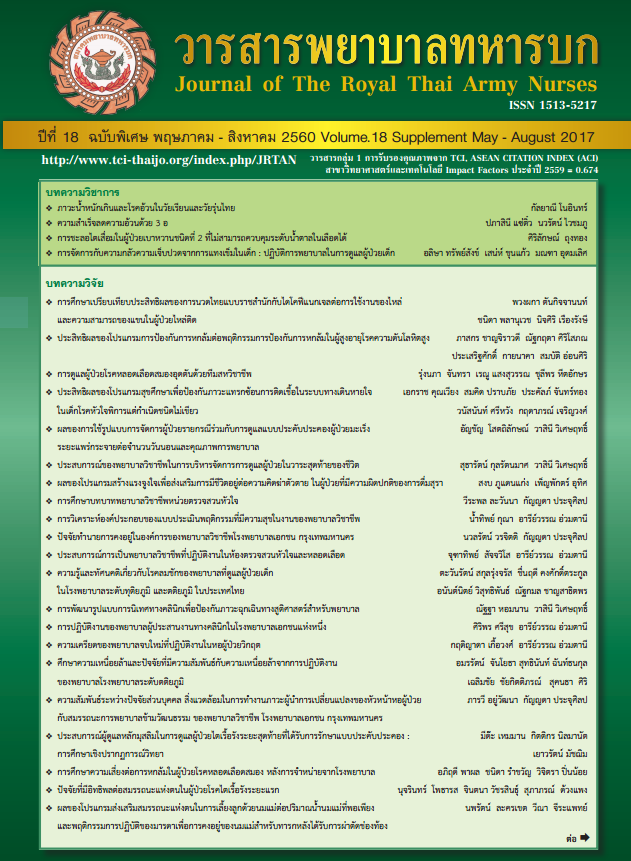การพัฒนารูปแบบการบันทึกทางการพยาบาล ในหออภิบาลทารกแรกเกิด โรงพยาบาลสมุทรสาคร
Keywords:
บันทึกทางการพยาบาล คุณภาพของการบันทึกทางการพยาบาล, คุณค่าของรูปแบบการบันทึก, หออภิบาลทารกแรกเกิด, Nursing records model, Quality of nursing record, value of the records model, Neonatal intensive care unitAbstract
การวิจัยครั้งนี้เป็นการวิจัยและพัฒนา มีวัตถุประสงค์เพื่อ 1) ศึกษาสภาพปัญหาการบันทึกทางการพยาบาลในหออภิบาลทารกแรกเกิด โรงพยาบาลสมุทรสาคร 2) พัฒนารูปแบบการบันทึกทางการพยาบาล และ 3) เปรียบเทียบผลของการใช้รูปแบบการบันทึกที่พัฒนาขึ้นก่อนและหลังการพัฒนา กลุ่มตัวอย่างแบ่งเป็น 2 กลุ่ม ซึ่งได้จากการคัดเลือกอย่างเจาะจง ได้แก่ 1) พยาบาลวิชาชีพที่ปฏิบัติงานในหออภิบาลทารกแรกเกิด จำนวน 15 คน และ 2) แบบบันทึกทางการพยาบาลของผู้ป่วยก่อนและหลังพัฒนาอย่างละ 30 แฟ้ม เครื่องมือที่ใช้ในการวิจัย คือ1) โครงการอบรมพยาบาลวิชาชีพและแบบทดสอบความรู้เรื่องการบันทึกทางการพยาบาล 2) รูปแบบบันทึกทางการพยาบาลที่พัฒนาขึ้น 3) แบบตรวจสอบคุณภาพของการบันทึกทางการพยาบาล และ 4) แบบสอบถามการรับรู้คุณค่าของการใช้รูปแบบการบันทึกทางการพยาบาล เครื่องมือวิจัยได้ผ่านการหาความตรงตามเนื้อหาและความเที่ยงได้ค่าความเที่ยงของแบบตรวจสอบคุณภาพของการบันทึกทางการพยาบาลซึ่งแบ่งเป็น 3 ตอน ได้แก่ ความครอบคลุมตามกระบวนการพยาบาล ความถูกต้องตามหลักการบันทึกและความต่อเนื่องของการบันทึกเท่ากับ 0.95, 0.95, และ0.89 ตามลำดับ และความเที่ยงของแบบสอบถามการรับรู้คุณค่าของการใช้รูปแบบการบันทึกทางการพยาบาลเท่ากับ 0.97 วิเคราะห์ข้อมูลโดยการหาความถี่ ร้อยละ ค่าเฉลี่ย ส่วนเบี่ยงเบนมาตรฐาน Mann-Whitney U test และสถิติทดสอบทีผลการวิจัยสรุปได้ดังนี้ 1) ปัญหาการบันทึกทางการพยาบาลที่พบ ได้แก่ (1) วิธีการบันทึกไม่ครอบคลุมตามกระบวนการพยาบาล บันทึกไม่ถูกต้อง ไม่ครบถ้วน และไม่ต่อเนื่อง (2) แบบบันทึกไม่เหมาะสมทำให้บันทึกไม่ครอบคลุม และไม่สอดคล้องตามกระบวนการพยาบาล ไม่ครอบคลุมปัญหาของผู้ป่วยแบบองค์รวม และ มีแบบฟอร์มที่มีการบันทึกซ้ำซ้อน (3) ไม่มีคู่มือการใช้รูปแบบบันทึกทางการพยาบาลสำหรับใช้เป็นแนวทางการการบันทึกและตัวอย่าง 2) รูปแบบการบันทึกทางการพยาบาลที่พัฒนาขึ้นประกอบด้วย วิธีการบันทึกและแบบบันทึกตามกระบวนการพยาบาล และคู่มือการใช้รูปแบบการบันทึกทางการพยาบาลที่เอื้อต่อการบันทึกอย่างรวดเร็ว ครบถ้วน ครอบคลุมความต้องการของผู้ป่วยแบบองค์รวมและอย่างต่อเนื่อง และ 3) ค่าเฉลี่ยของคะแนนคุณภาพของการบันทึกทางการพยาบาลและการรับรู้คุณค่าของการรูปแบบการบันทึกทางการพยาบาลโดยรวมหลังพัฒนาสูงกว่าก่อนพัฒนารูปแบบบันทึกทางการพยาบาลอย่างมีนัยสำคัญทางสถิติที่ระดับ 0.01
The Development of a Nursing Record Model in a NeonatalIntensive Care Unit of Samutsakhon Hospital
The purposes of this research and development were: 1) to explore the problems of a nursing record model at a Neonatal Intensive Care Unit at Samutsakhon Hospital, 2) to develop a nursing record model, and 3) to compare the effects of using the developed record model in terms of quality of nursing record and nurses’ perceived value of the record model before and after the development. The samples were selected by purposive sampling including 2 groups: 1) fifteen professional nurses who worked at the neonatal intensive care ward and 2) nursing records of before (30 records) and after (30 records) implementation. Research tools consisted of 1) a training project and a knowledge test of nursing records, 2) the developed nursing records model, 3) an audit checklist for quality of nursing record, and 4) questionnaires on value perception of the nursing records model. All tools were tested for validity and reliabilities. The reliabilities of quality of nursing records which included three sections (nursing process completeness, accuracy of charting, and continuity of charting) were 0.95, 0.95, and 0.89 respectively. The reliability of value perception on the records model was 0.97. Data were analyzed by frequency, percentage, mean, standard deviation, Mann-Whitney U test, and t-test. The major findings were as follows. 1) The problems of the nursing records consisted of (1) the charting method was not based on nursing process, incorrect, incomplete, and discontinuous. (2) The current forms were inappropriate, so the records did not cover or correspond to the nursing process; and patients’ holistic problems were incomprehensive. Moreover, some other forms recorded the same things. (3) There was no charting manual to guide and give examples. 2) The developed nursing records model comprised charting procedures, forms, and a manual. Nurses could document immediately, completely, holistically to patients’ needs, and continuously. Finally, 3) the mean scores of the quality of nursing records and the nurses’ perception on the value of the records model after developing were significantly higher than before (p <0.01).
Downloads
Downloads
How to Cite
Issue
Section
License
บทความหรือข้อคิดเห็นใดใดที่ปรากฏในวารสารพยาบาลทหารบกเป็นวรรณกรรมของผู้เขียน ซึ่งบรรณาธิการหรือสมาคมพยาบาลทหารบก ไม่จำเป็นต้องเห็นด้วย
บทความที่ได้รับการตีพิมพ์เป็นลิขสิทธิ์ของวารสารพยาบาลทหารบก
The ideas and opinions expressed in the Journal of The Royal Thai Army Nurses are those of the authors and not necessarily those
of the editor or Royal Thai Army Nurses Association.






